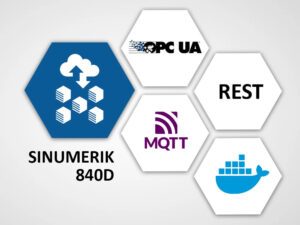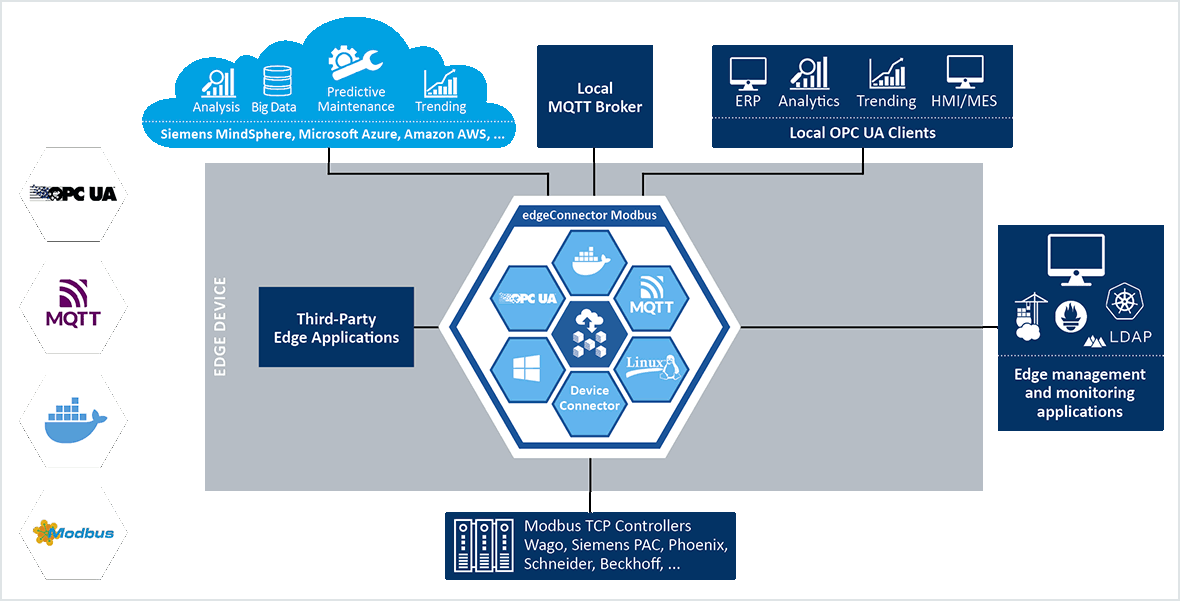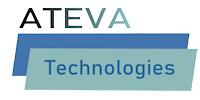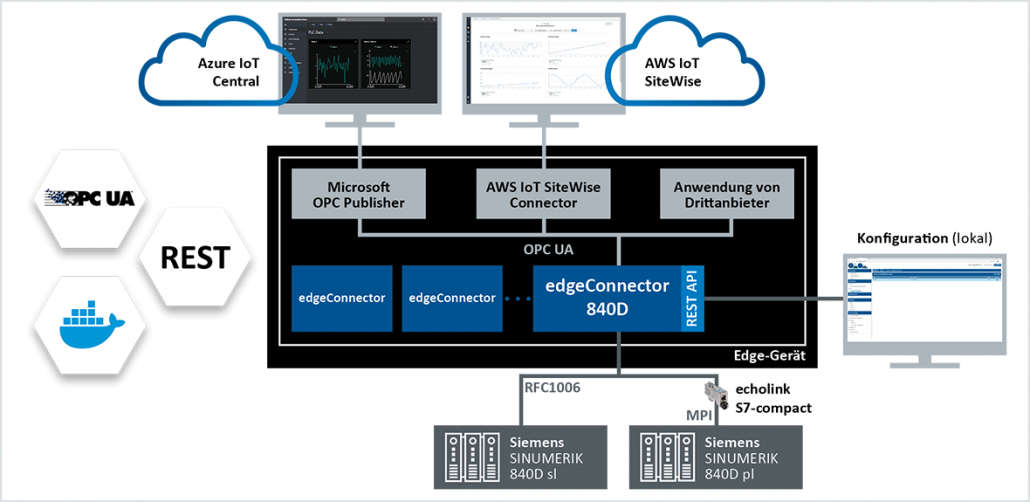Description
Edgeconnector 840D Software module for connecting SINUMERIK 840D controllers to industrial IoT applications

Container technology with access to SINUMERIK 840D Solution Line and Power Line data via OPC UA and MQTT with flexible deployment options for higher-level applications
edgeConnector 840D connects to the Siemens SINUMERIK 840D Solution Line and Power Line controllers without any intervention in the machine configuration and provides the data as an OPC UA server. In addition, the data can also be transmitted to MQTT brokers using MQTT. All process parameters from the NC part (axis, tool, program data), as well as the PLC part (status, program sections, alarms) and the drive data can be read out. As a Docker container, the product offers flexible deployment options, e.g. on standard IPCs or devices running Azure IoT Edge or AWS IoT Greengrass.
The application can be easily configured locally via an integrated web interface. It can also be managed remotely using the REST API. The configuration is flexible and includes precisely coordinated security settings (e.g. role-based access rights for OPC UA client applications).
The new product, which is also based on virtualization and container technology, benefits from Softing’s deep experience with brownfield connectivity through MQTT and OPC UA technology and provides the data for new and highly efficient IoT solution architectures.

Accessing Tooling Machine Data from OPC UA Applications
- Provision of SINUMERIK 840D Solution Line and Power Line data
- Pre-defined namespace, customizable for special machine data sets
- Automatic tool recognition and listing of all available magazines and tools
- Standardized OPC UA communication for data integration into management systems like ERP, MES, or SCADA or for data exchange with other docker containers like Microsoft OPC Publisher or Amazon AWS IoT SiteWise
- Connection of up to 20 SINUMERIK 840D controllers with one Container Runtime
- Reading of NC/PLC alarms, as well as GUD variables and R parameters
- Dedicated for retrofit upgrades of existing SINUMERIK controllers
Easy Cloud-driven or Local Deployment
- Container images stored in different online repositories like Docker Hub, Azure Container Registry (ACR) or Amazon Elastic Con-tainer Registry (ECR)
- Simple data transmission to an MQTT broker using the MQTT publisher functionality for local or cloud-based solutions
- Recipe manager functionality for writing process data from the cloud to controllers (MQTT Subscriber)
- Licensing via Softing Floating License Server
Lightweight Flexible Container Solution
- Less resources plus increased scalability and flexibility
- Support of security standards as SSL/TLS, X.509 certificates, authentication, and data encryption
- Highly flexible state-of-the-art application to be deployed, adjusted, or started and stopped immediately, if needed
- Deployment and configuration also via management systems such as Kubernetes, Azure IoT Edge or AWS IoT Greengrass
| edgeConnector 840D | ||
| Supported Controllers | Siemens SINUMERIK 840D Solution Line, software version V2.7 and higher Siemens SINUMERIK 840D Power Line, software version V5.3 and higher | |
| Supported Protocols |
| |
| Supported MQTT Specifications | V3.1, V3.1.1 & V5 | |
| Supported MQTT Features |
| |
| Supported OPC Specifications | OPC Unified Architecture V1.04 | |
| OPC UA Roles | OPC UA Server | |
| OPC UA Profiles | Data Access | |
| OPC UA Security | Security methods | Aes256Sha256-RsaPss Aes128SHA256-RsaOaep Basic256Sha256 Basic256 Basic128Rsa15 None |
| Authentication | Anonymous Username and password Certificate | |
| OPC Compliance | Test based on compliance test tools of OPC Foundation | |
| Configuration Interface Authentication |
| |
| Logging, Diagnostics |
| |
| Supported Operating Systems | Linux (Docker Engine), Windows 10 and Windows 11 (Docker Desktop), Windows Server 2019 and Windows Server 2022 (Docker Enterprise Edition) | |
| Supported Architectures | AMD64, ARM64, ARM32 | |
| Supported Container Orchestration Systems | Kubernetes (K8s), Amazon ECS | |
| Minimum Hardware Requirements | 320 MB free disk space, 2 GB RAM | |
| Licensing | Licensed via Softing Floating License Server | |
| Demo Version | 20 PLC connections timed at 72 hours | |
| REST-API | Access using the edgeConfigurator, download via Docker Hub | |
All our downloads from our Clouds
- Softing License Manager V4.63 (Windows)
- Softing License Manager V4.63 (Container for Linux)
- Softing License Manager | Checksums V4.63
- Preconfigured symbol files for SINUMERIK 840D
- edgeConnector 840D | DockerHub
- edgeConnector 840D | Microsoft Azure Marketplace
- Latest dataFEED Exporter Version
| Scope of Delivery | |
| Software | dataFEED edgeConnector 840D, download via Docker Hub or Azure Marketplace |
| License Key | E-mail delivery |
| Documentation | Online help (German / English) and online: www.github.com/SoftingIndustrial/datafeed-edge-connector |
| Order Numbers | |
| LRL-XX-161001 | edgeConnection – Perpetual License* |
| LMA-XX-161001 | edgeConnection – Software Upgrade License |
| * edgeConnection License already include 1 Year Software Upgrade license (LMA-XX-161001) | |
| Additional Products and Services | |
| edgeAggregator | |
| GPA-CS-041000 | NETLink S7-Compact (for S7-300/S7-400 without CP or Ethernet connection) |
| 6FC5851-1XC45-4YA8 | SINUMERIK 840D sl CNC software and SINUMERIK Operate, toolbox including NCVar Selector (please order directly from Siemens) |
Softing dataFEED edgeConnector 840D is a containerized SINUMERIK 840D SolutionLine and PowerLine connectivity module adding OPC UA Server and MQTT Publisher functionality. The software can run as IoT Edge Module. After the deployment, it is possible to configure Southbound and Northbound communication via local GUI or REST interface.
For southbound communication it is possible to connect up to 20 SINUMERIK 840D SolutionLine and PowerLine controllers. The Namespace configuration is pre-configured and can be extended via STEP7/TIA Portal or .awl files.
The northbound communication runs with standardized OPC UA communication for data integration into management systems like ERP, MES or SCADA or for data exchange with other docker containers like Microsoft OPC Publisher for cloud scenarios. In addition MQTT is available as protocol to connect MQTT Broker in local or cloud environments.
The application supports security standards like SSL/TLS, X.509 certificates, authentication and data encryption. The container runs for 72h in demo mode. Fully activate the application via BYOL from Softing. This also requires the installation of the Softing floating license server available for Windows/Linux.
After the Docker image has been pulled, a Docker container can be started. The webserver and OPC UA Server of the module have to be exposed on the host machine if dataFEED edgeConnector 840D shall be accessed from outside the dockerized environment.
To start dataFEED edgeConnector 840D with the default ports mapped 1:1 to the host machine:
docker container run -p 443:443 -p 4897:4897 softingindustrial/edgeconnector-840dSofting licenseServer
Softing licenseServer is used to host network software licenses (also called floating licenses or shared licenses) that are installed locally on an individual users’ machine. The network licenses can be shared among many users and/or applications.
Softing licenseServer fulfills requests to run a network application if the required license is available. When the network license is released (for example, a user closes the application), the license is moved to the license server’s available license pool and is made available for other checkout requests.
The license server is used by several Softing products like the edgeConnector or plantPerfect product families.
Please read the user guide of the licenseServer for install and usage instructions. It is available as download on the Softing product pages using the licenseServer.
Installation
Download the docker image using the following command:
docker pull softingindustrial/license-server
Use the following commands to create and configure Docker container:
mkdir -p /var/lib/license-server
mkdir -p /var/lib/license-server/licenses
mkdir -p /var/lib/license-server/config
mkdir -p /var/lib/license-server/users
docker create --name license-server -p 8000:8000 -p 6200:6200 -v /var/lib/licenseserver/licenses:/root/.x-formation -v /var/lib/license-server/users:/root/sflm/users -v /var/lib/license-server/config:/root/sflm/config --restart=always softingindustrial/license-server
docker start license-server
The following ports are used by the license server:
| Port | Service |
|---|---|
| 6200 | Network License Server |
| 8000 | HTTPS Web Server |
These ports are mapped in the docker create call above 1:1 to the ports of the host system. Of course, you can map them to different ports on the host system by changing the first number on the -p option (example: -p 8400:8000).
To disable HTTPS, use the docker create command without a port mapping for port 8000.
Note: You will need access to the Web server to add licenses.
These following volumes are used by the license server:
| Volume | Description |
|---|---|
| /root/.x-formation | Folder to store the license files |
| /root/sflm/users | Folder to store the user data |
| /root/sflm/config | Folder to store the configuration of the license server |
The directory /var/lib/license-server is used to persist the configuration of the license server container. Of course, you can store it in a different folder on the host system by changing the first folder on the -v option (example: -v /home/xxx/ls:/root/.x-formation).
The option –restart=always will start the container on the startup of the system or restart it on failure.
Start the container with the following command:
docker start license-server
Stop the container with the following command:
docker stop license-server
Remove the container with the following command:
docker rm -f license-server

